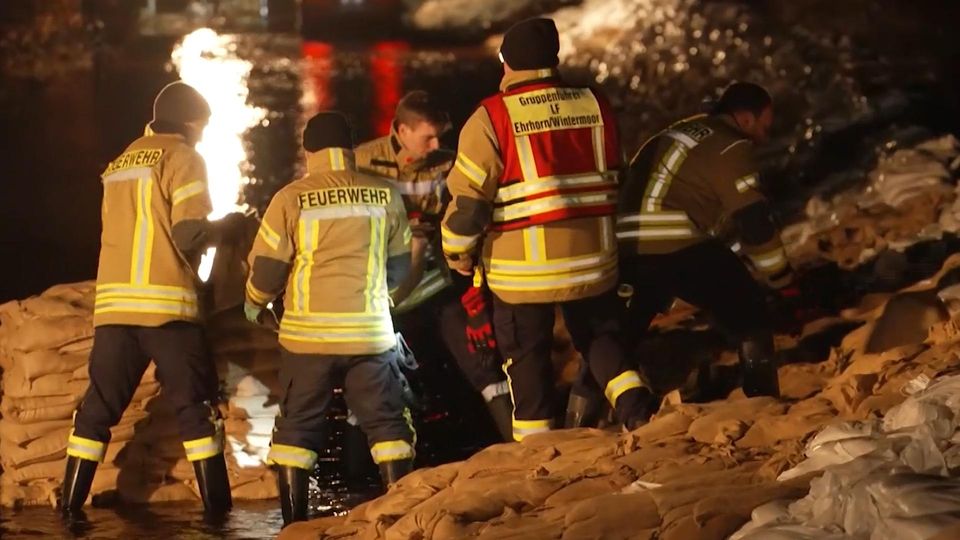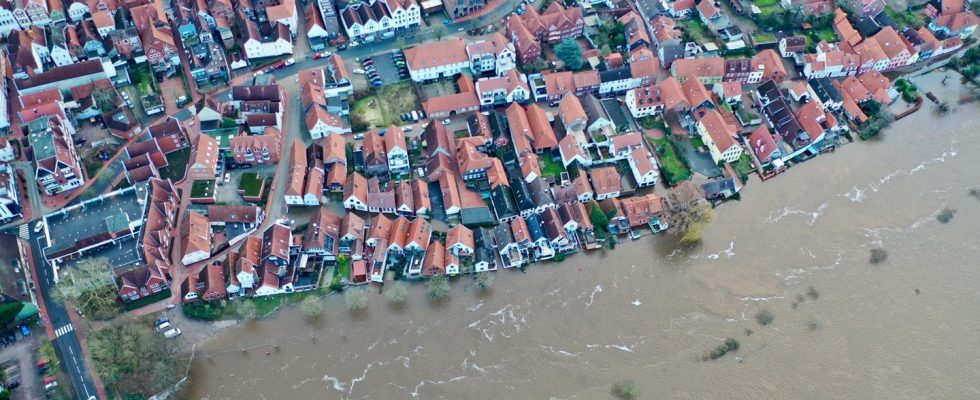Floods in Germany
Minor flooding has been given the all-clear in Dresden – the situation in Lower Saxony remains tense
View of the partially submerged old town of Verden an der Aller. The flood situation remains tense in large parts of Lower Saxony
© DPA
The flood situation in parts of Germany remains tense on Friday. A key question is how much rain falls. But at least there is good news from Dresden.
The situation remains threatening in the flood areas. The German Weather Service (DWD) predicted further rainfall. “There will be a good momentum again until Saturday, but it will no longer rain in such large quantities,” said DWD meteorologist Christian Herold on Friday morning in Offenbach. Then tone it down a little. According to Herold, the greatest amounts of rain are expected on Friday and Saturday in the north of North Rhine-Westphalia. In the north, in the Bremen and Hamburg area, the meteorologist predicts less precipitation.
However, the situation in Lower Saxony is still tense. Although fears of a storm surge have not yet been confirmed and the flood situation varies regionally – the all-clear cannot yet be given for the whole of Lower Saxony, said state fire director Dieter Rohrberg on Friday in Hanover. Accordingly, the situation is shifting slightly from the Harz towards the Celle and Oldenburg districts.
The water on the Weser is still rising
In Lower Saxony, areas on the rivers Aller, Leine, Oker, Hase and Weser in the southern and central parts of the country are affected. The water level measured on Friday morning exceeded the highest reporting level in many areas. Downstream of the Weser, the water levels would rise even further, according to a situation report from the State Office for Water Management, Coastal and Nature Conservation (NLWKN). Particularly in the lower reaches of the Middle Weser, it is not yet possible to speak of an easing of tensions.
Lower Saxony’s Interior Minister Daniela Behrens emphasized in an interview with Deutschlandfunk that they had learned from previous floods and that the state and municipalities had invested a lot of money in flood protection and technical equipment. Operational concepts for flood situations have worked very well so far.

On Friday morning it was said that a so-called extraordinary event had still been detected in six districts and the city of Oldenburg. This makes it easier for districts, for example, to access support staff.
On Thursday, the dikes could no longer withstand the masses of water everywhere, and others threatened to become unstable. Evacuations have been prepared in some places. In the community of Langlingen, around 120 people left their houses and apartments as a precaution on Friday night, and the evacuation of a street began in Lilienthal.
There was still no all-clear around Bremen either. According to the authorities on Thursday evening, numerous houses along the Wümme in the Katrepel area are surrounded by water and without electricity. Most of the residents have left this area. In the Timmersloh district the water is at the dikes. Streets and fields are flooded. According to the interior authorities, measures to secure the dike have already had to be taken several times.
“Major flood situation” in North Rhine-Westphalia
The Ministry of the Environment also did not give the all-clear for North Rhine-Westphalia, despite stagnating or falling water levels. “We still have a major flood situation,” said NRW Environment Minister Oliver Krischer (Greens) on Friday in Düsseldorf. So far the consequences have remained manageable and there have been no casualties. There is no risk of dam failure at the dams, nor an uncontrolled overflow. The flood protection systems would have held.
In eastern Germany, many fire brigades are still in constant use. At least there is some good news from Dresden. In the Saxon state capital, the Elbe remained below the expected six meter water level. Two meters is normal. A flood protection gate is already being dismantled, it was said. Dresden’s environmental mayor Eva Jähnigen (Greens) explained on Deutschlandfunk this morning that alert level 3 should be reduced over the course of Friday. All protective measures have been effective and there has been no major damage so far.
Christmas floods
The flood situation is easing to some extent – the risk of heavy rain is increasing again
The water level of the Elbe has been falling again since Friday night, according to data from the state flood center. The Elbe briefly reached a level of 5.95 meters. The state environmental office announced on Friday that the risk of flooding has now been completely eliminated for the other rivers in Saxony.
Dike in Thuringia opened in a controlled manner
In the north of Thuringia, a dike on the Helme River was opened in a controlled manner to avert the risk of flooding on the state border between Thuringia and Saxony-Anhalt. The Kyffhäuserkreis district announced on Friday night that the water was now flowing into fields. The opening was necessary because water had been specifically drained from the overloaded Kelbra reservoir for several days and the helmets were therefore carrying a lot of water. The highest flood alert level 4 has been in effect for the Helmets for two days. According to the district, firefighters have laid around 6,000 sandbags since Thursday to protect the small town of Mönchpfiffel-Nikolausrieth and raise the dikes.
The situation in the town of 300 residents eased on Friday. The water from the helmets is draining “as planned,” said a spokesman for the Kyffhäuserkreis district office. But there is still no complete all-clear. The water level in the helmets is constantly monitored and a district crisis team is still in action.
The Pretzien weir near Magdeburg and Schönebeck in Saxony-Anhalt was opened on Thursday. This means that around a third of the Elbe’s water is channeled past the two cities through a flood canal and over meadows and fields before flowing back into the Elbe.

